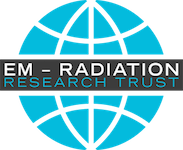ICBE-EMF is dedicated to the protection of humans and other species from the harmful effects of non-ionizing radiation. Of highest concern are children, pregnant women, and those with chronic health conditions including those who are Electromagnetically Hypersensitive (EHS). We attribute the growth of EHS to the rapid expansion in anthropogenic (human-caused) electromagnetic fields. EHS symptoms may occur through use of devices or exposure to infrastructure, such as mobile phones, DECT cordless landlines, Wi-Fi/Bluetooth enabled computers, Wi-Fi routers, smart meters, base station antennas, electric vehicles, power lines, household electrical appliances and other low intensity exposures.
All biology uses electromagnetic fields as well as chemical signalling. Widely used EMF (electrical and magnetic fields) are new and very different from those found in nature, making them disruptive to normal biological functioning, even at what are labelled as low levels.
EHS is a multisystemic physical response, with symptoms that can vary among individuals due to anatomical and physiological differences. Symptoms can include sleep problems, fatigue, headache, dizziness, heart palpitation, tinnitus (ringing in the ear), skin rash, chemical sensitivity, visual, sensory, and mood disturbances. The US National Council on Disability’s 2022 Health Equity Framework, recognizes that “electrical hypersensitivity is associated with the use of wireless communications and electrical technologies and other sources of non-ionizing radiation, which may trigger disabling and life-threatening cardiac, respiratory, neurological, and other adverse physical reactions.”
The distress and disability associated with EHS is recognised by numerous social, scientific and medical organisations (WHO, 2004[1]). According to the European Commission’s EESC 2019 Report on Digitalization: Challenge for Europe, “Each day the number of ES sufferers increases: according to new estimates, between 3% and 5% of the population are electro-sensitive, meaning that some 13 million Europeans may suffer from this syndrome, which has various names: electro-sensitivity, Wi-Fi syndrome, microwave syndrome, electromagnetic hypersensitivity, etc.”[2] As these technologies continue to expand, the incidence of EHS will grow.
Many of these exposures are involuntary and now inescapable. Common outcomes of this are job, school and home loss, separation from family and friends, inability to access medical care and general lack of access to all areas of the public domain. The unmitigated, neglected widespread disruption of lives [3],[4] is inhumane and deeply troubling.
Our serious concern: EHS is an escalating humanitarian crisis
The European Academy for Environmental Medicine (EUROPAEM)[5] reports that EHS symptoms are occurring in response to low intensity exposures, which are orders of magnitude below the exposure limits currently supported by many governments. Current exposure limits do not protect those with EHS and there are no medical registries or trainings to facilitate appropriate registration or support for this group. Government regulatory agencies should–but do not—investigate claims of harm and update policies to ensure greater protection of the health and welfare of the population[6]. Due to low medical awareness, most cases of EHS are unrecognized or misdiagnosed, wasting healthcare resources due to inappropriate treatment.
ICBE-EMF has been reviewing multiple types of scientific evidence and individual case reports closely and contributing to Electromagnetic Hypersensitivity science. Our goal is to see EHS formally recognized as an EMF-induced external cause of injury by public health agencies worldwide, and greater recognition of the needs of those who are EHS-disabled, so they have access to safer homes, healthcare, education, employment, opportunities, amenities, and equity of access in all public domains. Such recognition should lead to increased public awareness, research funding, and strengthened calls for lower EMF exposure limits. EHS persons must be provided with low EMF spaces for residence, work, school and general public domain access. Low EMF essential spaces need to be urgently established—not just to reduce severity for people with EHS, but to broadly reduce the incidence of EHS.

